First Electric Tramcars
All closed tram types put in service until 1906 had seats on two longitudinal benches with the passengers facing each other. This is called "Risca ao Meio, which became a type indication for the older tramcars. All these trams, except for the last build type by A Constructora, were also known as "Carros Antigos".Transformados
The first electric tramcars of Porto were converted out of existing mule cars / steam tram trailers of the 7-window type. In the first years for these transformations electric equipments and trucks were acquired from several suppliers. Apparently the CCFP wanted to compare and choose the best for later acquirements. The first three cars with the numbers 1-3 were put in service in 1895 and had equipments of Thomson-Houston.
Tram no.3 at Carmo around 1902
Except for Thomson-Houston in the first years also electric equipments were bought from Walker (Cleveland, Ohio), Siemens & Halske (Berlin, Germany) and Schuckert & co (Nürnberg, Germany). The trucks came from the same companies but in October 1897 three trucks were ordered from BSI (Remscheid, Germany) to be equipped with Walker motors.
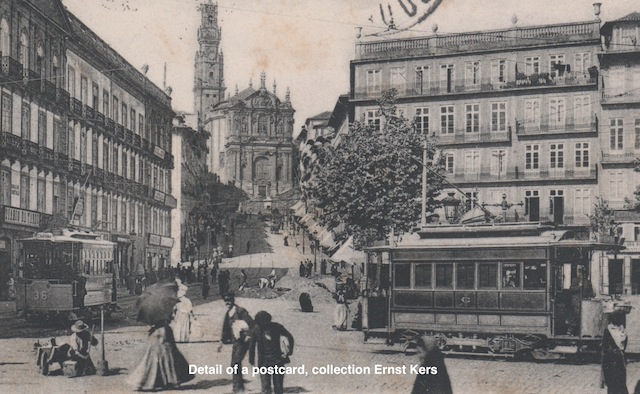
Two Transformados at Praça, the right one
has a BSI truck
The first Brill-21E trucks were ordered in 1898. These trucks became the standard in Porto for all 4-wheel cars. For electric equipments the CCFP in later years limited their orders to Siemens-Schuckert and General Electric. The Walker motors were already phased out by 1905.
On 31 december 1902 there were 24 transformados numbered 1-14, 18-19, 28-32 and 35-37. As there existed different types of mule cars / steam tram trailers, also of the transformados several sub types existed. Of all transformados seating arrangement was on longitudinal benches and except for one the capacity was 18 on benches of 4.25 m. It is unknown exactly how many cars there were of each sub type. Of the “7-window” type there were at least 11 and the “8-window” type at least 6 transformados.
Transformado 37 at Batalha around 1904
Of the other transformados no photos are yet found to determine the type. One unique car with the number 67 was made in 1904 out of two small type mule cars. This last car had a capacity of 22 on two benches of 5.35 m, but no photos or drawings are known.
Top of page
The first new constructed cars
In 1898/9 the workshops of the CCFP constructed three new cars, which without doubt were also fitted with imported trucks and electric equipments. These cars were supposed to get the numbers 10-12 but were soon renumbered to 15-17. It is not clear if they had ever the numbers 10-12. The bodies were copies of the 7-window transformado type.The local firm A Constructora delivered four new constructed cars in 1900 getting the numbers 20-23. These were also copies of the 7-window transformado type. The 20-22 had equipments of Schuckert & co, 23 got Siemens & Halske equipments.
Top of page
German cars
In 1898 two complete cars were ordered from two different suppliers in Germany. Without doubt the CCFP wanted to compare both.Schuckert & co. delivered a “5-window” type of car of clearly German model as known from constructors like Herbrand and Falkenried. This car had seating for 18 on longitudinal benches of 4.30 m. Originally it got the number 13 but about 1901 it was renumbered into 27. It had disappeared from the fleet by 1916.
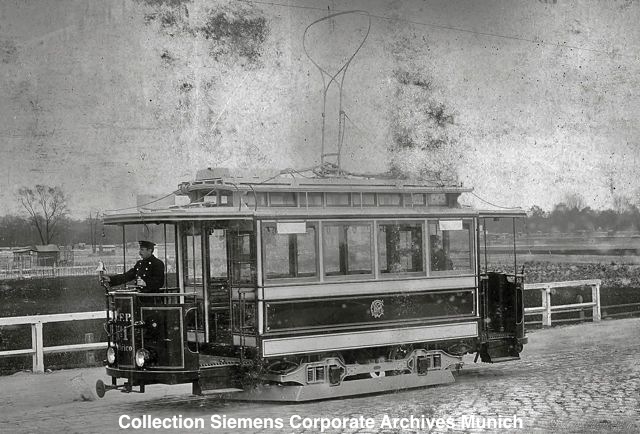
Works photo Siemens & Halske 1898
Siemens & Halske delivered a tram with four large windows and seating for only 16 on two benches of 4.06 m. A works photo shows the tram with a bow collector and a BSI truck. The car received the number 14, but about 1901 it got the number 26. The car was also unique in having two front lights. It was still on the fleet list of 1916 but had disappeared by 1919.
Top of page
A Constructora cars with 5 windows
The local firm A Constructora delivered six carros electricos with bodies which were inspired by the 5-window Schuckert car.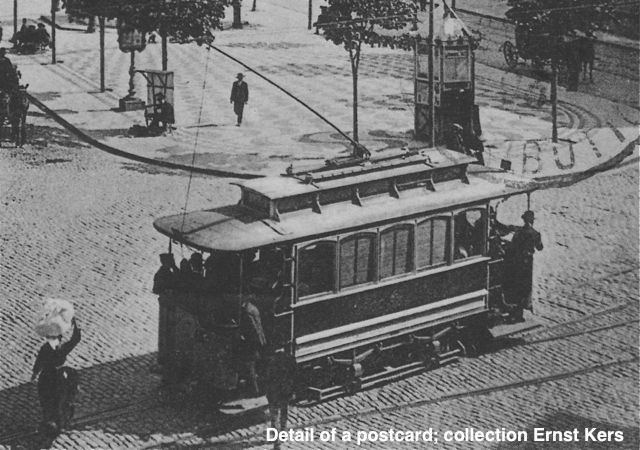
Tram no.34 at Batalha in 1902
The history of these cars is rather confusing. The first two were delivered in 1901, did get Siemens & Halske equipments and the numbers 24-25. In 1902 the next two were delivered with equipments of Schuckert & co and the numbers 33-34. However car 34 had a runaway accident in Rua de Santo Antonio in November of the same year and doubts arose about the braking capacity. The fleet numbers 33-34 disappeared by 1903. In 1903 the last two cars of the type were made by A Constructora getting the numbers 38-39 and Walker equipments. In 1904 the cars with the numbers 55-56 appeared and are considered to have been the 33-34 after getting new electric equipments. It is guessed that car 24 swopped numbers with 8-window transformado 35 around 1904. The cars seated 18 on two benches of 4.31 m and had larger platforms than the transformados and the Schuckert car.
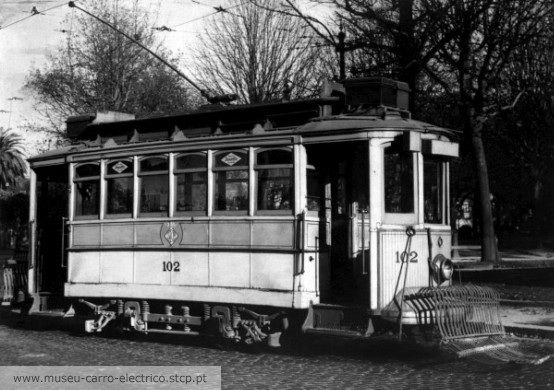
STCP 102 at Boavista around 1947
It seems that with at least some of these tramcars the 5-window arrangement was changed to six windows without changing the size of the body. Together with getting new closed Brill-type platforms, this changed significant their exterior.
Top of page
The final years of the Carros Antigos
Already soon no difference was made by the CCFP between the several types of pre-1904 cars. As they became the smallest and oldest cars they were mainly used on less important services and the first to be phased out. Of the 39 cars available in 1909 there were probably 27 left by 1925. In the period 1934-1940 there were still 12. The STCP took over 11 but kept only four of these cars on the fleet and renumbered them to 101-104. No.101 was a transformado type with 7 windows, 102-103 were 5-window Constructora cars but with the window arrangement changed into 6 and 104 was an 8-window transformado. The last car, still with open platforms, was scrapped in the late 1950’s. A replica of this car, build in 1997, is now part of the museum collection. A 7-window car, which was converted by the STCP to trailer 22, is reconverted to museum-tram 22.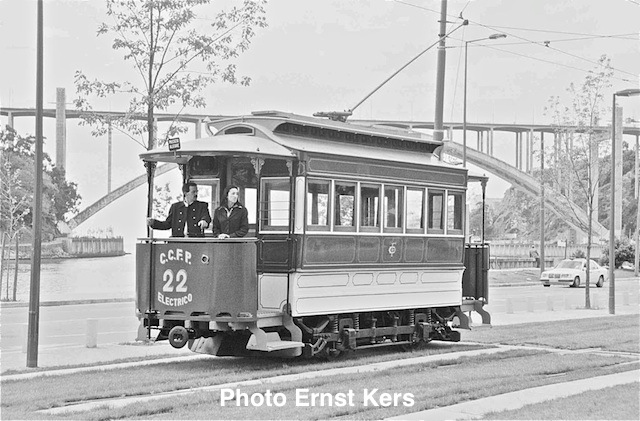
Museumtram 22 in 2000